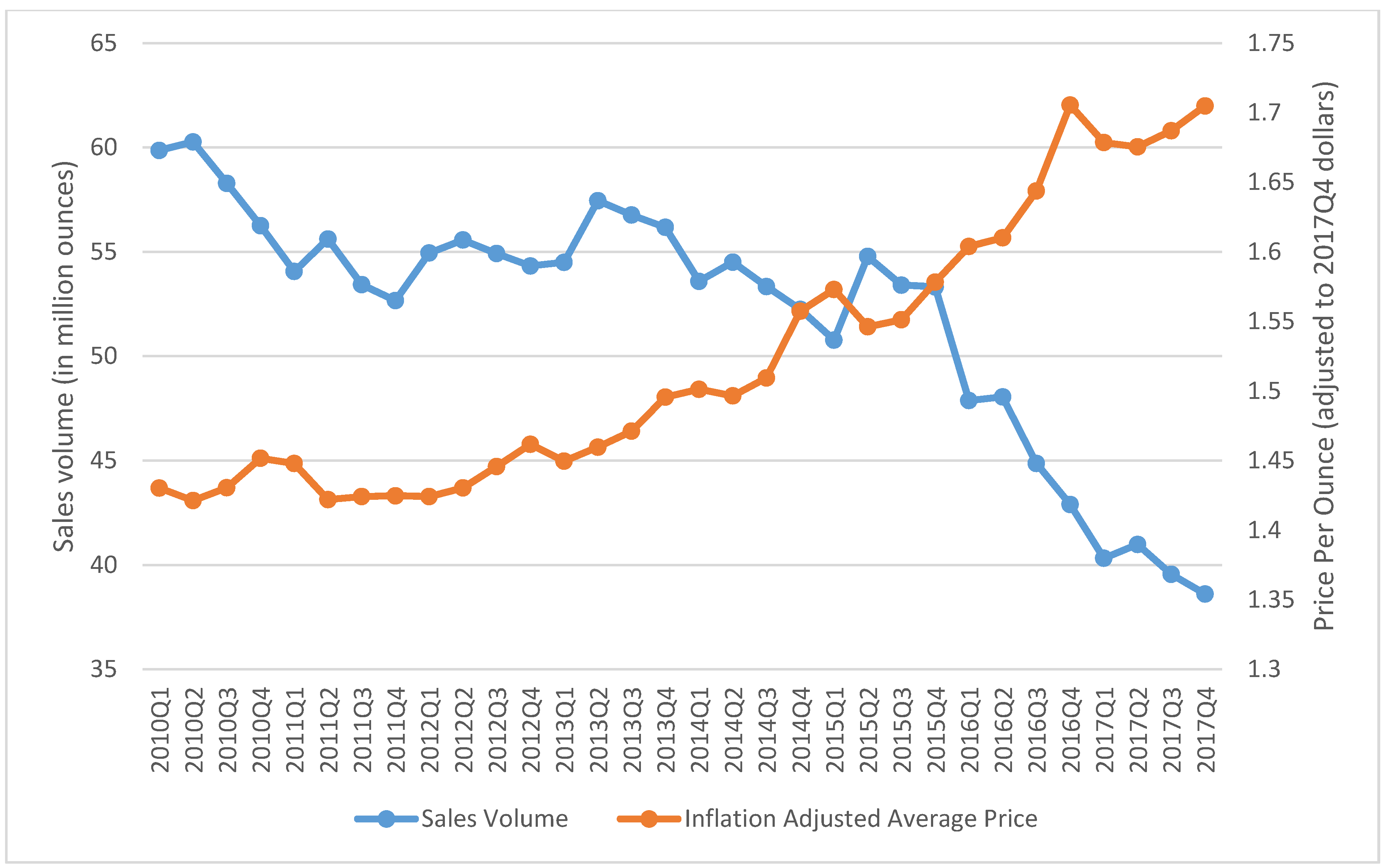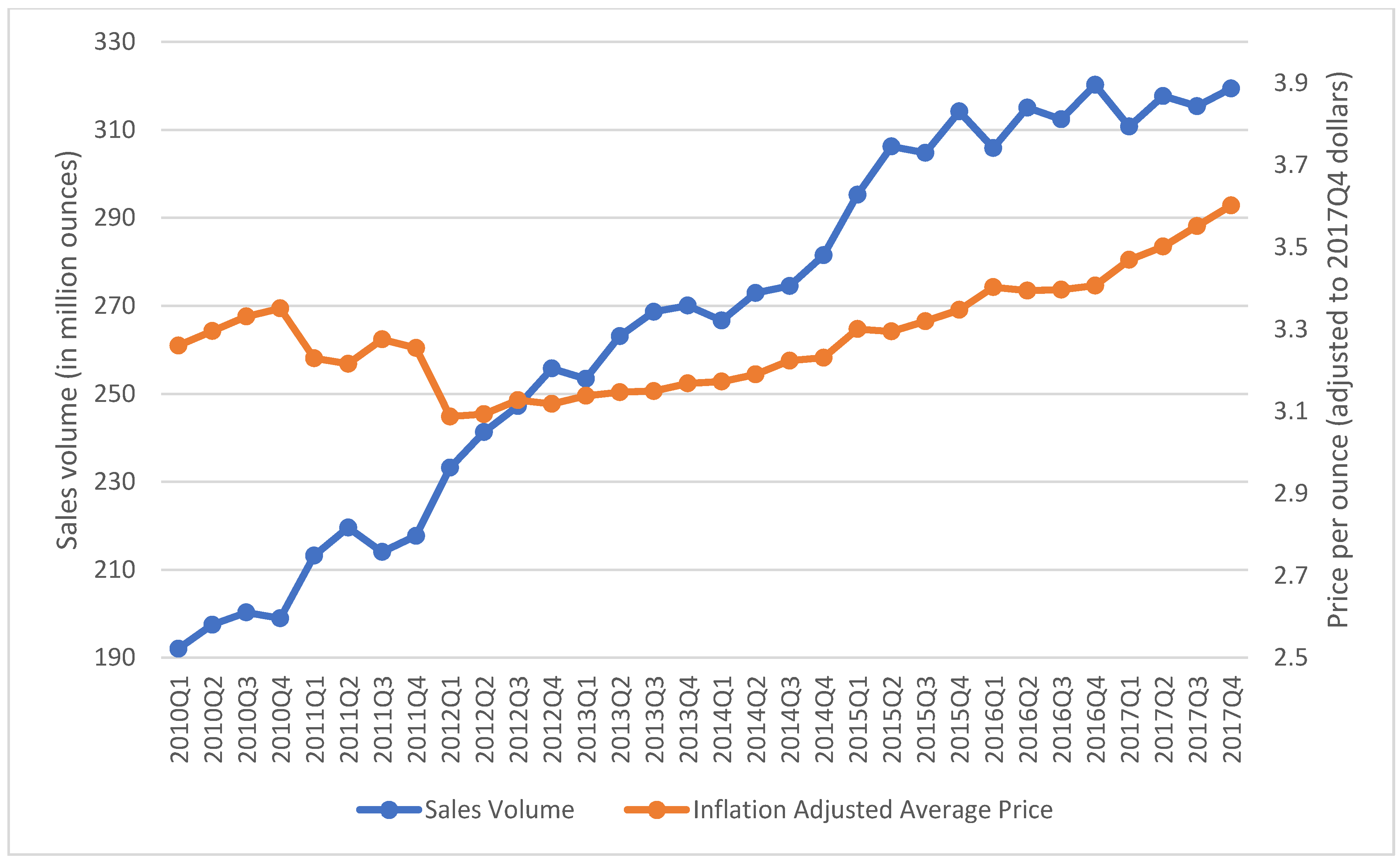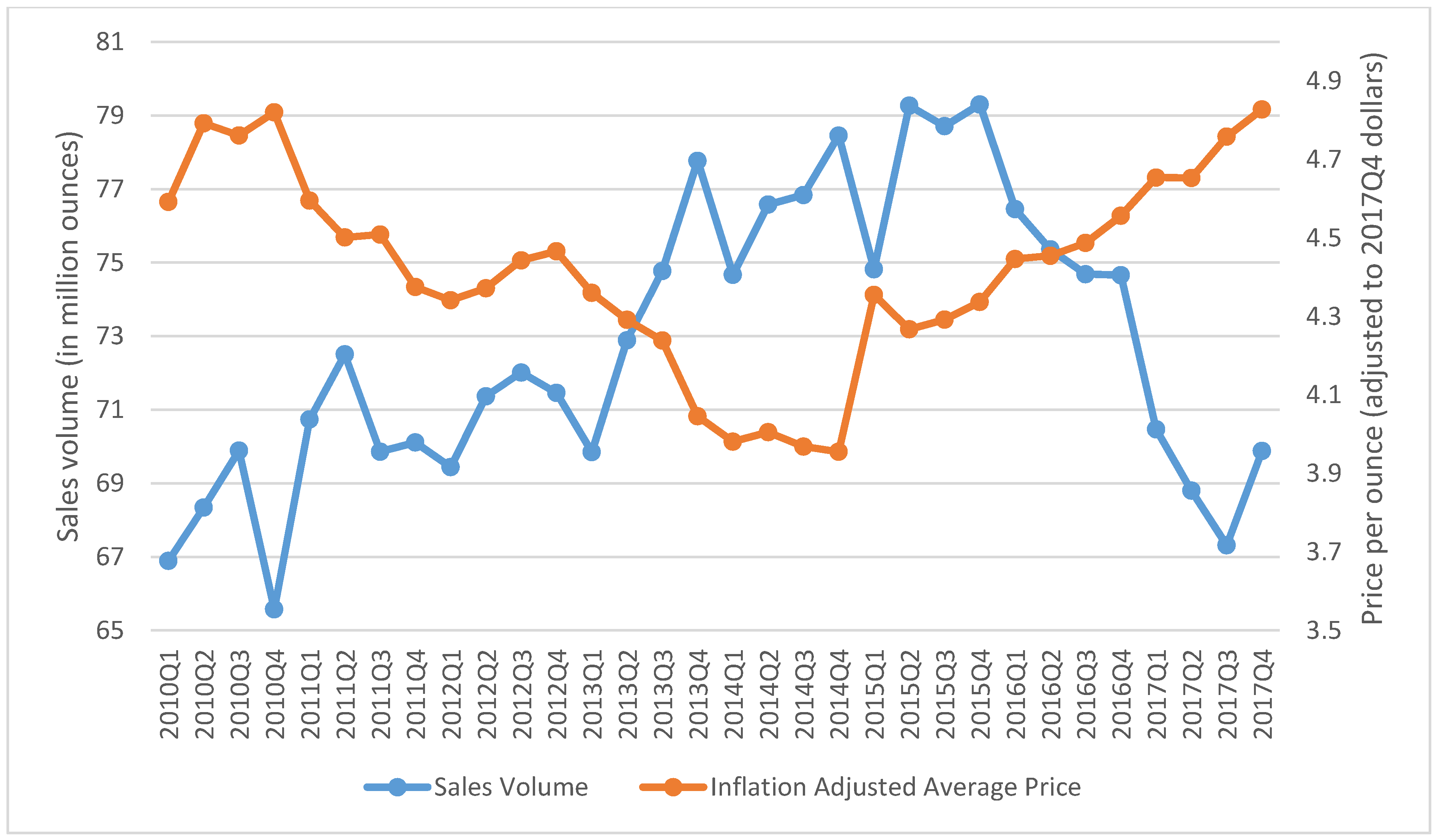The Association between E-Cigarette Price and TV Advertising and the Sales of Smokeless Tobacco Products in the USA
Abstract
:1. Introduction
2. Materials and Methods
2.1. Data
2.2. Measures
2.2.1. Per Capita Sales of SLT Products
2.2.2. Inflation-Adjusted SLT, E-Cigarette, and Cigarette Prices
2.2.3. E-Cigarette TV Ratings
2.3. Statistical Analyses
3. Results
3.1. Trends of SLT Product Sales Volume and Price
3.2. Demand for Chewing Loose Leaf
3.3. Demand for Moist Snuff
3.4. Demand for Snus
4. Discussion
5. Conclusions
Supplementary Materials
Author Contributions
Funding
Institutional Review Board Statement
Informed Consent Statement
Data Availability Statement
Acknowledgments
Conflicts of Interest
References
- US Centers for Disease Control and Prevention. Smokeless Tobacco: Products and Marketing. Available online: https://www.cdc.gov/tobacco/data_statistics/fact_sheets/smokeless/products_marketing/index.htm (accessed on 21 February 2021).
- Delnevo, C.D.; Hrywna, M.; Miller Lo, E.J.; Wackowski, O.A. Examining market trends in smokeless tobacco sales in the United States: 2011–2019. Nicotine Tob. Res. 2020. [Google Scholar] [CrossRef]
- Federal Trade Commission. Smokeless Tobacco Report for 2018. Available online: https://www.ftc.gov/system/files/documents/reports/federal-trade-commission-cigarette-report-2018-smokeless-tobacco-report-2018/p114508smokelesstobaccoreport2018.pdf (accessed on 7 March 2021).
- US Department of Health and Human Services. The Health Consequences of Smoking—50 Years of Progress: A Report of the Surgeon General; US Department of Health and Human Services, Centers for Disease Control and Prevention: Atlanta, GA, USA, 2014.
- WHO International Agency for Research on Cancer. IARC Monographs on the Evaluation of Carcinogenic Risks to Humans: Volume 89. Smokeless Tobacco and Some Tobacco-Specific N-Nitrosamines; WHO International Agency for Research on Cancer: Lyon, France, 2007. [Google Scholar]
- Boffetta, P.; Hecht, S.; Gray, N.; Gupta, P.; Straif, K. Smokeless tobacco and cancer. Lancet Oncol. 2008, 9, 667–675. [Google Scholar] [CrossRef]
- Muthukrishnan, A.; Warnakulasuriya, S. Oral health consequences of smokeless tobacco use. Indian J. Med. Res. 2018, 148, 35. [Google Scholar] [PubMed]
- Piano, M.R.; Benowitz, N.L.; FitzGerald, G.A.; Corbridge, S.; Heath, J.; Hahn, E.; Pechacek, T.F.; Howard, G.; American Heart Association Council on Cardiovascular Nursing. Impact of smokeless tobacco products on cardiovascular disease: Implications for policy, prevention, and treatment: A policy statement from the American Heart Association. Circulation 2010, 122, 1520–1544. [Google Scholar] [CrossRef] [Green Version]
- Carpenter, C.M.; Connolly, G.N.; Ayo-Yusuf, O.A.; Wayne, G.F. Developing smokeless tobacco products for smokers: An examination of tobacco industry documents. Tob. Control 2009, 18, 54–59. [Google Scholar] [CrossRef]
- Hatsukami, D.K.; Ebbert, J.O.; Feuer, R.M.; Stepanov, I.; Hecht, S.S. Changing smokeless tobacco products: New tobacco-delivery systems. Am. J. Prev. Med. 2007, 33, S368–S378. [Google Scholar] [CrossRef]
- Curry, L.E.; Pederson, L.L.; Stryker, J.E. The changing marketing of smokeless tobacco in magazine advertisements. Nicotine Tob. Res. 2011, 13, 540–547. [Google Scholar] [CrossRef] [PubMed]
- Seidenberg, A.B.; Rodgers, E.J.; Rees, V.W.; Connolly, G.N. Youth access, creation, and content of smokeless tobacco (“dip”) videos in social media. J. Adolesc. Health 2012, 50, 334–338. [Google Scholar] [CrossRef] [PubMed]
- Timberlake, D.S.; Pechmann, C.; Tran, S.Y.; Au, V. A content analysis of Camel Snus advertisements in print media. Nicotine Tob. Res. 2011, 13, 431–439. [Google Scholar] [CrossRef] [PubMed]
- Seidenberg, A.B.; Rees, V.W.; Connolly, G.N. Swedish match marketing on YouTube. Tob. Control 2010, 19, 512–513. [Google Scholar] [CrossRef]
- U.S. Food & Drug Administration. FDA Grants First-Ever Modified Risk Orders to Eight Smokeless Tobacco Products. Available online: https://www.fda.gov/news-events/press-announcements/fda-grants-first-ever-modified-risk-orders-eight-smokeless-tobacco-products (accessed on 17 February 2021).
- Huang, J.; Duan, Z.; Kwok, J.; Binns, S.; Vera, L.E.; Kim, Y.; Szczypka, G.; Emery, S.L. Vaping versus JUULing: How the extraordinary growth and marketing of JUUL transformed the US retail e-cigarette market. Tob. Control 2019, 28, 146–151. [Google Scholar] [CrossRef] [Green Version]
- Collins, L.; Glasser, A.M.; Abudayyeh, H.; Pearson, J.L.; Villanti, A.C. E-cigarette marketing and communication: How e-cigarette companies market e-cigarettes and the public engages with e-cigarette information. Nicotine Tob. Res. 2019, 21, 14–24. [Google Scholar] [CrossRef] [PubMed]
- Zhu, S.-H.; Gamst, A.; Lee, M.; Cummins, S.; Yin, L.; Zoref, L. The use and perception of electronic cigarettes and snus among the US population. PLoS ONE 2013, 8, e79332. [Google Scholar]
- Tuchman, A.E. Advertising and demand for addictive goods: The effects of e-cigarette advertising. Mark. Sci. 2019, 38, 994–1022. [Google Scholar] [CrossRef]
- Ali, F.R.M.; Diaz, M.C.; Vallone, D.; Tynan, M.A.; Cordova, J.; Seaman, E.L.; Trivers, K.F.; Schillo, B.A.; Talley, B.; King, B.A. E-cigarette Unit Sales, by Product and Flavor Type—United States, 2014–2020. Morb. Mortal. Wkly. Rep. 2020, 69, 1313. [Google Scholar] [CrossRef] [PubMed]
- Wang, T.W.; Neff, L.J.; Park-Lee, E.; Ren, C.; Cullen, K.A.; King, B.A. E-cigarette use among middle and high school students—United States, 2020. Morb. Mortal. Wkly. Rep. 2020, 69, 1310. [Google Scholar] [CrossRef]
- Jamal, A.; Gentzke, A.; Hu, S.S.; Cullen, K.A.; Apelberg, B.J.; Homa, D.M.; King, B.A. Tobacco use among middle and high school students—United States, 2011–2016. Morb. Mortal. Wkly. Rep. 2017, 66, 597. [Google Scholar] [CrossRef] [Green Version]
- McMillen, R.C.; Gottlieb, M.A.; Shaefer, R.M.W.; Winickoff, J.P.; Klein, J.D. Trends in electronic cigarette use among US adults: Use is increasing in both smokers and nonsmokers. Nicotine Tob. Res. 2014, 17, 1195–1202. [Google Scholar] [CrossRef]
- Creamer, M.R.; Wang, T.W.; Babb, S.; Cullen, K.A.; Day, H.; Willis, G.; Jamal, A.; Neff, L. Tobacco product use and cessation indicators among adults—United States, 2018. Morb. Mortal. Wkly. Rep. 2019, 68, 1013. [Google Scholar] [CrossRef] [PubMed] [Green Version]
- Wang, T.W.; Gentzke, A.S.; Creamer, M.R.; Cullen, K.A.; Holder-Hayes, E.; Sawdey, M.D.; Anic, G.M.; Portnoy, D.B.; Hu, S.; Homa, D.M. Tobacco product use and associated factors among middle and high school students—United States, 2019. MMWR Surveill. Summ. 2019, 68, 1. [Google Scholar] [CrossRef] [Green Version]
- Cornelius, M.E.; Wang, T.W.; Jamal, A.; Loretan, C.G.; Neff, L.J. Tobacco Product Use among Adults—United States, 2019. Morb. Mortal. Wkly. Rep. 2020, 69, 1736. [Google Scholar] [CrossRef]
- Huang, J.; Gwarnicki, C.; Xu, X.; Caraballo, R.S.; Wada, R.; Chaloupka, F.J. A comprehensive examination of own-and cross-price elasticities of tobacco and nicotine replacement products in the US. Prev. Med. 2018, 117, 107–114. [Google Scholar] [CrossRef]
- Huang, J.; Tauras, J.; Chaloupka, F.J. The impact of price and tobacco control policies on the demand for electronic nicotine delivery systems. Tob. Control 2014, 23, iii41–iii47. [Google Scholar] [CrossRef] [PubMed] [Green Version]
- Ernster, V.L. Advertising and promotion of smokeless tobacco products. In Smokeless Tobacco Use in the United States: National Cancer Institute Monograph; National Cancer Institute: Bethesda, MD, USA, 1989; pp. 87–94. [Google Scholar]
- U.S. Food & Drug Administration. How FDA Is Regulating E-Cigarettes. Available online: https://www.fda.gov/news-events/fda-voices/how-fda-regulating-e-cigarettes (accessed on 14 October 2020).
- Mantey, D.S.; Cooper, M.R.; Clendennen, S.L.; Pasch, K.E.; Perry, C.L. E-cigarette marketing exposure is associated with e-cigarette use among US youth. J. Adolesc. Health 2016, 58, 686–690. [Google Scholar] [CrossRef] [Green Version]
- Duan, Z.; Wang, Y.; Emery, S.L.; Chaloupka, F.J.; Kim, Y.; Huang, J. Exposure to e-cigarette TV advertisements among U.S. youth and adults, 2013–2019. PLoS ONE 2021, 16, e0251203. [Google Scholar] [CrossRef]
- US Census Bureau. Population and Housing Unit Estimates. Available online: https://www.census.gov/programs-surveys/popest.html (accessed on 23 March 2021).
- Bureau of Labor Statistics. Consumer Price Index. Available online: https://www.bls.gov/cpi/ (accessed on 23 March 2021).
- Chang, H.S.; Kinnucan, H.W. Measuring exposure to advertising: A look at gross rating points. Agribusiness 1992, 8, 413–423. [Google Scholar] [CrossRef]
- Czoli, C.D.; White, C.M.; Reid, J.L.; OConnor, R.J.; Hammond, D. Awareness and interest in IQOS heated tobacco products among youth in Canada, England and the USA. Tob. Control 2020, 29, 89–95. [Google Scholar] [CrossRef] [PubMed]
- Mirbolouk, M.; Charkhchi, P.; Kianoush, S.; Uddin, S.I.; Orimoloye, O.A.; Jaber, R.; Bhatnagar, A.; Benjamin, E.J.; Hall, M.E.; DeFilippis, A.P. Prevalence and distribution of e-cigarette use among US adults: Behavioral risk factor surveillance system, 2016. Ann. Intern. Med. 2018, 169, 429–438. [Google Scholar] [CrossRef] [PubMed]
- Cullen, K.A.; Gentzke, A.S.; Sawdey, M.D.; Chang, J.T.; Anic, G.M.; Wang, T.W.; Creamer, M.R.; Jamal, A.; Ambrose, B.K.; King, B.A. E-cigarette use among youth in the United States, 2019. JAMA 2019, 322, 2095–2103. [Google Scholar] [CrossRef]
- Ding, A. Youth are more sensitive to price changes in cigarettes than adults. Yale J. Biol. Med. 2003, 76, 115. [Google Scholar]
- Van Hasselt, M.; Kruger, J.; Han, B.; Caraballo, R.S.; Penne, M.A.; Loomis, B.; Gfroerer, J.C. The relation between tobacco taxes and youth and young adult smoking: What happened following the 2009 US federal tax increase on cigarettes? Addict. Behav. 2015, 45, 104–109. [Google Scholar] [CrossRef] [PubMed] [Green Version]
- Zheng, Y.; Zhen, C.; Dench, D.; Nonnemaker, J.M. US demand for tobacco products in a system framework. Health Econ. 2017, 26, 1067–1086. [Google Scholar] [CrossRef]
- Cotti, C.; Nesson, E.; Tefft, N. The effects of tobacco control policies on tobacco products, tar, and nicotine purchases among adults: Evidence from household panel data. Am. Econ. J. Econ. Policy 2016, 8, 103–123. [Google Scholar] [CrossRef]
- Huang, J.; Wang, Y.; Duan, Z.; Kim, Y.; Emery, S.L.; Chaloupka, F.J. Do e-cigarette sales reduce the demand for nicotine replacement therapy (NRT) products in the US? Evidence from the retail sales data. Prev. Med. 2020, 106376. [Google Scholar]
- Ali, F.R.M.; Dave, D.M.; Colman, G.J.; Wang, X.; Saffer, H.; Marynak, K.L.; Dench, D.; Grossman, M. Association of e-cigarette advertising with e-cigarette and cigarette use among US adults. Addiction 2021, 116, 1212–1223. [Google Scholar] [CrossRef] [PubMed]
- Cotti, C.D.; Courtemanche, C.J.; Maclean, J.C.; Nesson, E.T.; Pesko, M.F.; Tefft, N. The Effects of E-Cigarette Taxes on E-Cigarette Prices and Tobacco Product Sales: Evidence from Retail Panel Data; National Bureau of Economic Research: Cambridge, MA, USA, 2020. [Google Scholar]
- Yao, T.; Sung, H.-Y.; Huang, J.; Chu, L.; Helen, G.S.; Max, W. The impact of e-cigarette and cigarette prices on e-cigarette and cigarette sales in California. Prev. Med. Rep. 2020, 20, 101244. [Google Scholar] [CrossRef]
- Pesko, M.F.; Huang, J.; Johnston, L.D.; Chaloupka, F.J. E-cigarette price sensitivity among middle-and high-school students: Evidence from monitoring the future. Addiction 2018, 113, 896–906. [Google Scholar] [CrossRef]
- Truth Initiative. What Is Zyn and What Are Oral Nicotine Pouches? Available online: https://truthinitiative.org/research-resources/emerging-tobacco-products/what-zyn-and-what-are-oral-nicotine-pouches (accessed on 17 February 2021).



| Variable | Mean | SD 1 | Min | Max |
|---|---|---|---|---|
| Per capita chewing loose leaf sales volume | 0.05 | 0.10 | 0.00 | 0.84 |
| Per capita chewing loose leaf sales volume (in log) | −4.13 | 1.84 | −13.90 | −0.18 |
| Per capita moist snuff sales volume | 0.29 | 0.46 | 0.00 | 3.28 |
| Per capita moist snuff sales volume (in log) | −2.72 | 2.10 | −13.02 | 1.19 |
| Per capita snus sales volume | 0.07 | 0.11 | 0.00 | 0.69 |
| Per capita snus sales volume (in log) | −4.25 | 2.24 | −15.59 | −0.37 |
| Average price of chewing loose leaf ($ per ounce) | 2.12 | 0.68 | 0.35 | 4.42 |
| Average price of chewing loose leaf (in log) | 0.70 | 0.32 | −1.04 | 1.49 |
| Average price of moist snuff ($ per ounce) | 3.49 | 1.03 | 1.79 | 7.30 |
| Average price of moist snuff (in log) | 1.21 | 0.29 | 0.58 | 1.99 |
| Average price of snus ($ per ounce) | 4.75 | 1.57 | 2.40 | 24.07 |
| Average price of snus (in log) | 1.52 | 0.27 | 0.88 | 3.18 |
| Average price of disposable e−cigarette ($ per piece) | 9.24 | 1.85 | 2.96 | 29.94 |
| Average price of disposable e−cigarette (in log) | 2.21 | 0.18 | 1.09 | 3.40 |
| Average price of cigarette ($ per stick) | 0.30 | 0.07 | 0.18 | 0.53 |
| Average price of cigarette (in log) | −1.23 | 0.21 | −1.71 | −0.64 |
| E−cigarette TV ratings | 531.58 | 512.01 | 1.00 | 2553.59 |
| E−cigarette TV ratings (in log) | 5.15 | 2.10 | 0.00 | 7.85 |
| Model 1 | Model 2 | Model 3 | Model 4 | Model 5 | |
|---|---|---|---|---|---|
| Chewing loose leaf price | −1.726 *** | −1.885 *** | −2.041 *** | −1.833 *** | −1.833 *** |
| (in log) | (0.362) | (0.435) | (0.473) | (0.477) | (0.478) |
| Disposable e-cigarette price | 0.211 | 0.133 | 0.186 | 0.186 | |
| (in log) | (0.158) | (0.147) | (0.145) | (0.145) | |
| Cigarette price | 1.204 ** | 2.125 *** | 2.125 *** | ||
| (in log) | (0.555) | (0.568) | (0.568) | ||
| Moist snuff price | −1.719 *** | −1.719 *** | |||
| (in log) | (0.597) | (0.597) | |||
| Snus price | −0.343 | −0.343 | |||
| (in log) | (0.306) | (0.307) | |||
| E−cigarette TV rating | 0.000 | ||||
| (in log) | (0.003) | ||||
| Observations | 2541 | 2169 | 2169 | 2168 | 2168 |
| R−squared | 0.946 | 0.949 | 0.950 | 0.954 | 0.954 |
| Model 1 | Model 2 | Model 3 | Model 4 | Model 5 | |
|---|---|---|---|---|---|
| Moist snuff price | −1.049 | −1.370 ** | −1.587 ** | −1.574 *** | −1.572 *** |
| (in log) | (0.699) | (0.666) | (0.716) | (0.564) | (0.564) |
| Disposable e-cigarette price | 0.329 ** | 0.290 * | 0.304 ** | 0.305 ** | |
| (in log) | (0.156) | (0.152) | (0.116) | (0.117) | |
| Cigarette price | 0.697 | 1.328 *** | 1.328 *** | ||
| (in log) | (0.568) | (0.486) | (0.486) | ||
| Chewing loose leaf price | −0.243 | −0.243 | |||
| (in log) | (0.306) | (0.306) | |||
| Snus price | −1.435 *** | −1.433 *** | |||
| (in log) | (0.311) | (0.312) | |||
| E-cigarette TV rating | 0.003 | ||||
| (in log) | (0.002) | ||||
| Observations | 2571 | 2195 | 2195 | 2168 | 2168 |
| R-squared | 0.963 | 0.965 | 0.966 | 0.968 | 0.968 |
| Model 1 | Model 2 | Model 3 | Model 4 | Model 5 | |
|---|---|---|---|---|---|
| Snus price | −1.971 *** | −2.111 *** | −2.174 *** | −2.177 *** | −2.174 *** |
| (in log) | (0.356) | (0.364) | (0.339) | (0.369) | (0.370) |
| Disposable e-cigarette price | 0.587 ** | 0.555 *** | 0.615 *** | 0.617 *** | |
| (in log) | (0.238) | (0.206) | (0.202) | (0.202) | |
| Cigarette price | 0.431 | 0.751 | 0.751 | ||
| (in log) | (0.931) | (0.835) | (0.835) | ||
| Chewing loose leaf price | −0.108 | −0.109 | |||
| (in log) | (0.487) | (0.487) | |||
| Moist snuff price | −0.496 | −0.494 | |||
| (in log) | (0.891) | (0.893) | |||
| E-cigarette TV rating | 0.006 | ||||
| (in log) | (0.003) | ||||
| Observations | 2569 | 2192 | 2192 | 2168 | 2168 |
| R-squared | 0.951 | 0.953 | 0.953 | 0.949 | 0.949 |
Publisher’s Note: MDPI stays neutral with regard to jurisdictional claims in published maps and institutional affiliations. |
© 2021 by the authors. Licensee MDPI, Basel, Switzerland. This article is an open access article distributed under the terms and conditions of the Creative Commons Attribution (CC BY) license (https://creativecommons.org/licenses/by/4.0/).
Share and Cite
Wang, Y.; Duan, Z.; Emery, S.L.; Kim, Y.; Chaloupka, F.J.; Huang, J. The Association between E-Cigarette Price and TV Advertising and the Sales of Smokeless Tobacco Products in the USA. Int. J. Environ. Res. Public Health 2021, 18, 6795. https://doi.org/10.3390/ijerph18136795
Wang Y, Duan Z, Emery SL, Kim Y, Chaloupka FJ, Huang J. The Association between E-Cigarette Price and TV Advertising and the Sales of Smokeless Tobacco Products in the USA. International Journal of Environmental Research and Public Health. 2021; 18(13):6795. https://doi.org/10.3390/ijerph18136795
Chicago/Turabian StyleWang, Yu, Zongshuan Duan, Sherry L. Emery, Yoonsang Kim, Frank J. Chaloupka, and Jidong Huang. 2021. "The Association between E-Cigarette Price and TV Advertising and the Sales of Smokeless Tobacco Products in the USA" International Journal of Environmental Research and Public Health 18, no. 13: 6795. https://doi.org/10.3390/ijerph18136795
APA StyleWang, Y., Duan, Z., Emery, S. L., Kim, Y., Chaloupka, F. J., & Huang, J. (2021). The Association between E-Cigarette Price and TV Advertising and the Sales of Smokeless Tobacco Products in the USA. International Journal of Environmental Research and Public Health, 18(13), 6795. https://doi.org/10.3390/ijerph18136795







